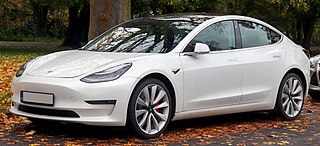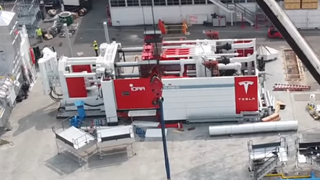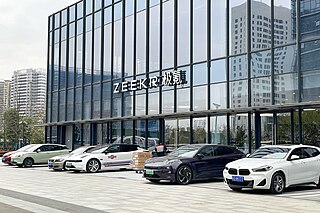
Elon Reeve Musk is a businessman and investor. He is the founder, chairman, CEO, and CTO of SpaceX; angel investor, CEO, product architect, and former chairman of Tesla, Inc.; owner, executive chairman, and CTO of X Corp.; founder of the Boring Company and xAI; co-founder of Neuralink and OpenAI; and president of the Musk Foundation. He is one of the wealthiest people in the world; as of April 2024, Forbes estimates his net worth to be $178 billion.
BYD Auto Co., Ltd. is the automotive subsidiary of BYD Company, a publicly listed Chinese multinational manufacturing company. It manufactures passenger battery electric vehicles (BEVs) and plug-in hybrid electric vehicles (PHEVs), collectively known as new energy vehicles (NEVs) in China. It also produces electric buses and trucks.

Tesla, Inc. is an American multinational automotive and clean energy company headquartered in Austin, Texas, which designs, manufactures and sells battery electric vehicles (BEVs), stationary battery energy storage devices from home to grid-scale, solar panels and solar shingles, and related products and services.

The Tesla Fremont Factory is an automobile manufacturing plant in Fremont, California, United States, operated by Tesla, Inc. The factory originally opened as General Motors' Fremont Assembly in 1962, and then was operated by New United Motor Manufacturing, Inc. (NUMMI), a joint venture of GM and Toyota from 1984. The joint venture ended when GM entered bankruptcy in 2009. In 2010, Toyota agreed to sell the plant to Tesla at a significant discount. The plant is the only production site for the Model S and Model X and also produces the Model 3, and Model Y.

Gigafactory Nevada is a lithium-ion battery and electric vehicle component factory in Storey County, Nevada, United States. The facility, located east of Reno, is owned and operated by Tesla, Inc. The factory supplies battery packs and drivetrain components for the company's electric vehicles, produces the Tesla Powerwall home energy storage device, and assembles the Tesla Semi. It is the largest and the first Tesla Gigafactory in the world. If fully built out, the building will have the largest footprint in the world.

The Tesla Model 3 is a battery electric mid-size sedan with a fastback body style built by Tesla, Inc., introduced in 2017. The vehicle is marketed as being more affordable to more people than previous models made by Tesla. The Model 3 was the world's top selling plug-in electric car for three years, from 2018 to 2020, before the Tesla Model Y, a crossover SUV based on the Model 3 chassis, took the top spot. In June 2021, the Model 3 became the first electric car to pass global sales of 1 million.

Tesla Energy Operations, Inc. is the clean energy division of Tesla, Inc. that develops, manufactures, sells and installs photovoltaic solar energy generation systems, battery energy storage products and other related products and services to residential, commercial and industrial customers.

The Tesla Model Y is a battery electric mid-size crossover SUV produced by Tesla, Inc. since 2020. The vehicle was presented in March 2019 as the company's fifth production model since its inception after the Roadster, Model S, Model X and Model 3.
Tesla, Inc., an electric vehicle manufacturer and clean energy company founded in San Carlos, California in 2003 by American entrepreneurs Martin Eberhard and Marc Tarpenning. The company is named after Serbian-American inventor Nikola Tesla. Tesla is the world's leading electric vehicle manufacturer, and, as of the end of 2021, Tesla's cumulative global vehicle sales totaled 2.3 million units.

Gigafactory Berlin-Brandenburg is a manufacturing plant for Tesla, Inc. in the municipality of Grünheide (Mark) in the Brandenburg state of Germany. The campus is located 35 kilometres (20 mi) south-east of central Berlin and some 8 kilometres (5 mi) southeast of the Berlin state boundary at Erkner and Rahnsdorf. Proximity to Berlin Brandenburg Airport was explicitly cited as a factor in choosing the site. It is Tesla's first manufacturing location in Europe.

The Tesla Roadster is an upcoming battery electric four-seater sports car to be built by Tesla, Inc. The company has said that it will be capable of accelerating from 0 to 60 mph in 1.9 seconds. The Roadster is the successor to Tesla's first production car, the 2008 Roadster.
Gigafactory Shanghai is an automobile manufacturing plant in Shanghai, China, operated by Tesla, Inc. Construction of the plant began in January 2019, initial production started in October, and the first production vehicles rolled out of the factory in December 2019, less than one year after groundbreaking. The main plant currently manufactures the Model 3 and Model Y. As of July 2023, Tesla says the factory has the capacity to build over 750,000 vehicles per year and is the primary production site for Tesla vehicles exported to regions without a Gigafactory.

The Tesla Cybertruck is a battery electric medium duty full-size pickup truck built by Tesla, Inc. since 2023. Introduced as a concept vehicle in November 2019, it has a triangular body with flat sheet stainless steel panels.

The Giga Press program is a series of aluminium die casting machines manufactured for Tesla, initially by Idra Group in Italy. Idra presses were the largest high-pressure die casting machines in production as of 2020, with a clamping force of 55,000 to 61,000 kilonewtons. Each machine weighs 410–430 tonnes (900,000–950,000 lb).

Gigafactory Texas is an automotive manufacturing facility in Austin, Texas built by Tesla, Inc. Construction began in July 2020, limited production of Model Y began before the end of 2021, and initial deliveries of vehicles built at the factory took place at an opening party called “Cyber Rodeo” on April 7, 2022.

Tesla, Inc. has been criticized for its cars, workplace culture, business practices, and occupational safety. Many of the criticisms are also directed toward Elon Musk, the company's CEO and Product Architect. Critics have also accused Tesla of deceptive marketing, unfulfilled promises, and fraud. The company is currently facing criminal and civil investigations into its self-driving claims. Critics have highlighted Tesla's downplaying of issues, and Tesla's alleged retaliation against several whistleblowers.

Zhejiang Zeekr Intelligent Technology Co., Ltd., trading as Zeekr is a Chinese premium electric automobile brand owned by Geely Automobile Holdings. Founded in 2021, it specializes in electric cars. Zeekr's products are built on the EV-focused Sustainable Experience Architecture (SEA) platform.

Tesla, Inc. is an American electric car manufacturer which as of January 2024 employs over 140,000 workers across its global operations, almost none of whom are unionized. Tesla CEO Elon Musk has commented negatively on trade unions in relation to Tesla. Despite allegations of high injury rates, long hours, and below-industry pay, efforts to unionize the workforce have been largely unsuccessful. As of February 2024, there are active labor disputes with Tesla in the United States, Germany and Sweden.

Gigafactory Mexico is a proposed manufacturing plant for Tesla, Inc. to be constructed near Monterrey, Mexico, with new vehicle production expected as early as 2026.
















